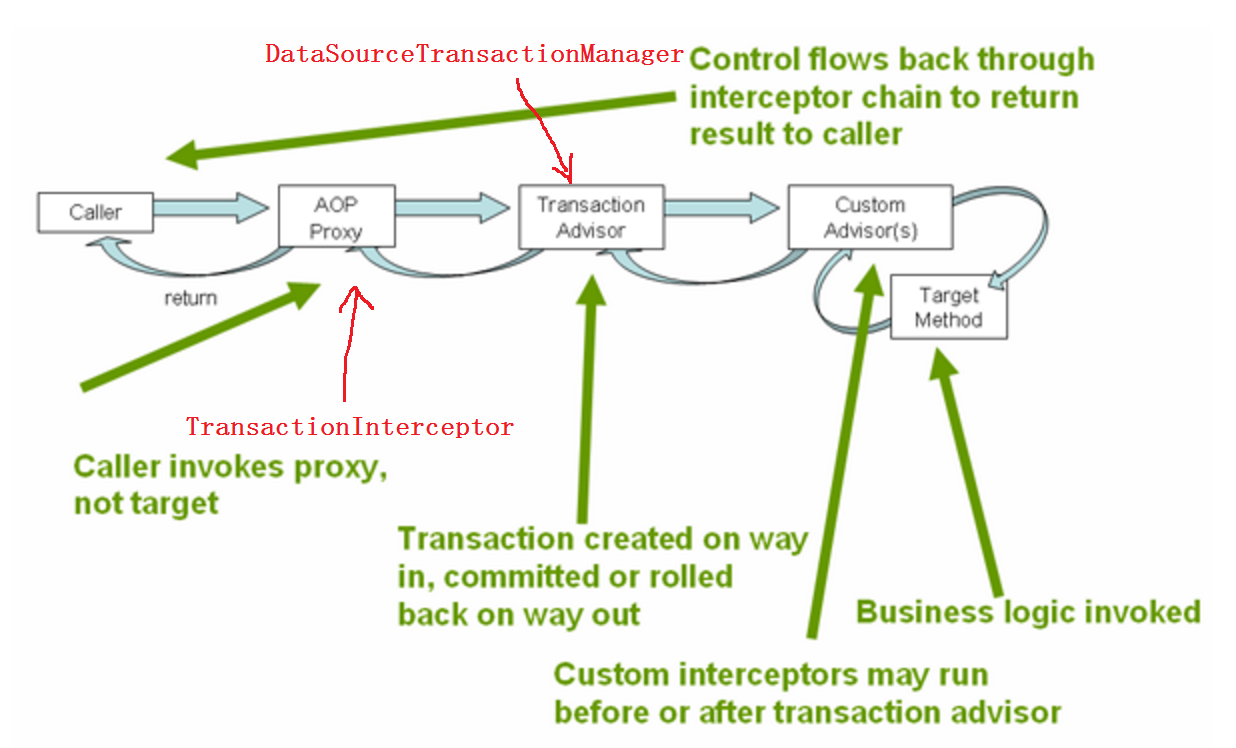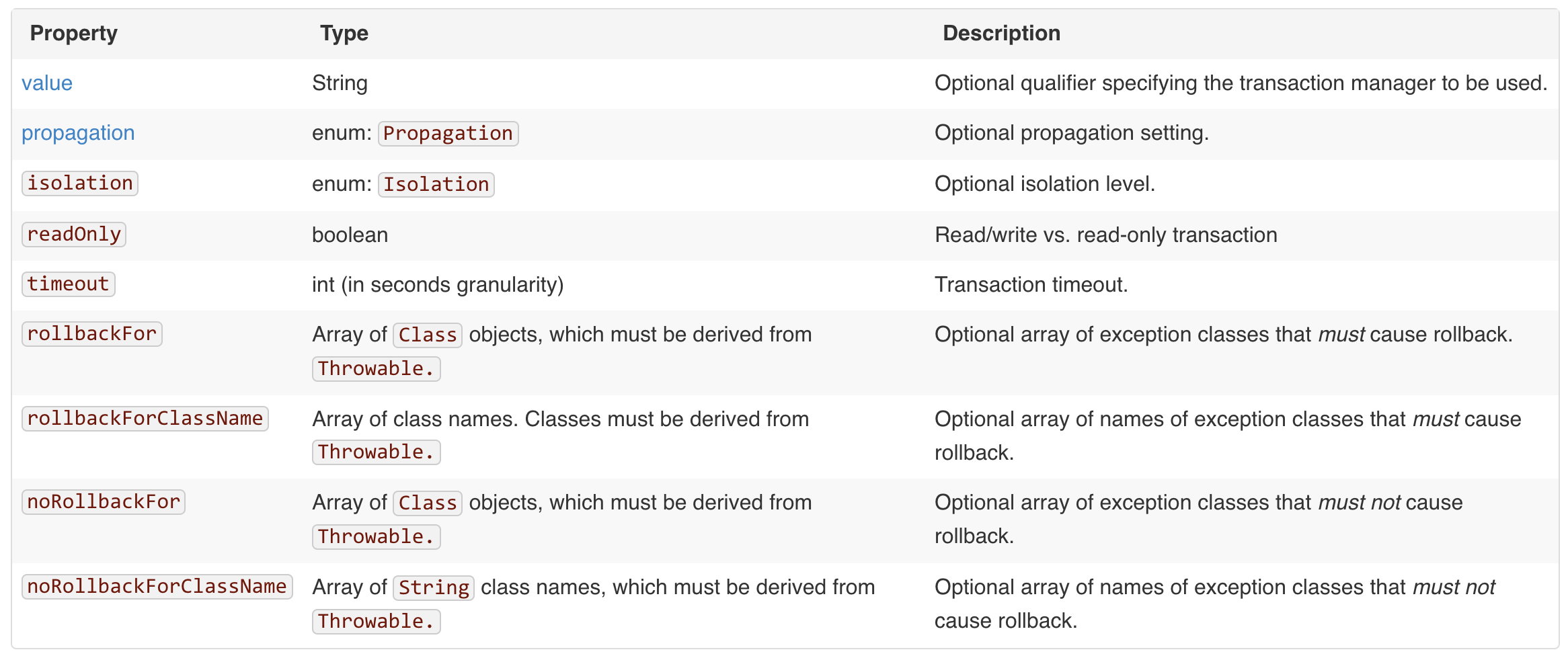最新又重新学习了一遍Spring的事务,这里做点总结,不做如何一步步配置的流水账。
1. 关键类
1 | public interface PlatformTransactionManager { |
事务真正的开始、提交、回滚都是通过PlatformTransactionManager这个接口来实现的,例如,我们常用的org.springframework.jdbc.datasource.DataSourceTransactionManager。
TransactionDefinition用于获取事务的一些属性,Isolation, Propagation,Timeout,Read-only,还定义了事务隔离级别,传播属性等常量。
TransactionStatus用于设置和查询事务的状态,如是否是新事务,是否有保存点,设置和查询RollbackOnly等。
2. 声明式事务
所谓声明式事务,就是通过配置的方式省去很多代码,从而让Spring来帮你管理事务。本质上就是配置一个Around方式的AOP,在执行方法之前,用TransactionInterceptor截取,然后调用PlatformTransactionManager的某个实现做一些事务开始前的事情,然后在方法执行后,调用PlatformTransactionManager的某个实现做commit或rollback. 如图:
声明式事务可以通过XML配置,也可以通过Annotation的方式来配置,还可以两种结合。平时项目中看到比较多的是两种结合的方式,在XML中配置数据源,事务管理器,然后AOP相关的通过@Transactional(该注解可以注在Class,Method上)来配置。(个人感觉,AOP相关的配置用XML配置挺繁琐的,还是注解好)例如:1
2
3
4
5
6
7
8
9
10
11
12
13
14
15
16
17
18
19
20<!-- 数据源定义,使用dbcp数据源 -->
<bean id="dataSource" class="org.apache.commons.dbcp.BasicDataSource">
<property name="driverClassName" value="com.mysql.jdbc.Driver"></property>
<property name="url" value="jdbc:mysql://localhost:3306/test"></property>
<property name="username" value="root"></property>
<property name="password" value="ali88"></property>
</bean>
<!--事务管理器-->
<tx:annotation-driven transaction-manager="txManager"/>
<bean id="txManager" class="org.springframework.jdbc.datasource.DataSourceTransactionManager">
<property name="dataSource" ref="dataSource"/>
</bean>
<!--JDBC模板-->
<bean id="jdbcTemplate" class="org.springframework.jdbc.core.JdbcTemplate">
<property name="dataSource">
<ref bean="dataSource" />
</property>
</bean>
1 | (readOnly = true) |
3. 事务属性
引用官方文档的表格
- value,在有多个事务管理器存在的情况下,用于标识使用哪个事务管理器
- isolation,事务的隔离级别,默认是Isolation.DEFAULT,这个DEFAULT是和具体使用的数据库相关的。关于隔离级别,可以参考MySQL事务学习总结
- readOnly, 是否只读,如果配置了true,但是方法里使用了update,insert语句,会报错。对于只读的事务,配置为true有助于提高性能。
- rollbackFor, noRollbackFor. Spring的声明式事务的默认行为是如果方法抛出RuntimeException或者Error,则事务会回滚,对于其他的checked类型的异常,不会回滚。如果想改变这种默认行为,可以通过这几个属性来配置。
- propagation, 后面会具体讲。
4. 事务的传播机制
| 类型 | 说明 |
|---|---|
| PROPAGATION_REQUIRED | 如果当前没有事务,就新建一个事务,如果已经存在一个事务中,加入到这个事务中。这是 最常见的选择。 |
| PROPAGATION_SUPPORTS | 支持当前事务,如果当前没有事务,就以非事务方式执行 |
| PROPAGATION_MANDATOR | 使用当前的事务,如果当前没有事务,就抛出异常 |
| PROPAGATION_REQUIRES_NEW | 新建事务,如果当前存在事务,把当前事务挂起 |
| PROPAGATION_NOT_SUPPORTED | 以非事务方式执行操作,如果当前存在事务,就把当前事务挂起 |
| PROPAGATION_NEVER | 以非事务方式执行,如果当前存在事务,则抛出异常 |
| PROPAGATION_NESTED | 如果当前存在事务,则在嵌套事务内执行。如果当前没有事务,则执行与 PROPAGATION_REQUIRED 类似的操作 |
其他的都还好理解,后面结合例子重点介绍下PROPAGATION_REQUIRED,PROPAGATION_REQUIRES_NEW,PROPAGATION_NESTED三种传播级别。
表结构和原始数据1
2
3
4
5
6
7
8
9mysql> select * from test;
+----+-------+
| id | money |
+----+-------+
| 3 | 500 |
| 5 | 500 |
| 7 | 600 |
+----+-------+
3 rows in set (0.00 sec)
- PROPAGATION_REQUIRED
1 |
|
执行完之后,test表的数据没有任何变化。
由于MysqlTest02中的事务传播类型是Propagation.REQUIRED,逻辑上有两个事务,但底层是共用一个物理事务的,第二个事务的抛出RuntimeExcetion导致事务回滚,对于这种传播类型,内层事务的回滚会导致外层事务回滚。所以数据库中的数据没有任何变化。
- PROPAGATION_REQUIRES_NEW
1 |
|
同样的代码,唯一的区别就是第二个事务的传播属性改成了REQUIRES_NEW,执行结果是啥?不好意思,第二个事务执行不了。
对于REQUIRES_NEW,逻辑上有两个事务,底层物理上也有两个事务,由于第一个事务和第二个事务更新的是同一条记录,对于Mysql默认的隔离级别REPEATABLE-READ来说,第一个事务会对该记录加排他锁,所以第二个事务就一直卡住了。
OK,我们把第二个事务的执行的SQL语句换成。1
update test set money = '501' where id = 5"
执行结果如下,可以看到只有第二个事务回滚了。1
2
3
4
5
6
7
8
9mysql> select * from test;
+----+-------+
| id | money |
+----+-------+
| 5 | 500 |
| 3 | 501 |
| 7 | 600 |
+----+-------+
3 rows in set (0.00 sec)
- PROPAGATION_NESTED
对于这种传播类型,物理上只有一个事务,不过可以有多个savePoint用来回滚。当然是用这种传播类型,需要数据库支持savePoint,使用jdbc的也是要3.0版本以上(这个不太确定)。
1 |
|
执行结果是如下,可以看到第一个事务和第三个事务提交成功了,第二个事务回滚了。物理上它们是在一个事务里的,只不过用到了保存点的技术。
1 | mysql> select * from test; |
5. 其他
在写测试代码的时候遇到了一个关于AOP的问题,可以看到我的测试代码,每个事务都是在一个新的class中写的。为什么不像下面这样写呢?1
2
3
4
5
6
7
8
9
10
11
12
13
14
15
public class MysqlTest01 {
private JdbcTemplate jdbcTemplate;
public void test01() {
jdbcTemplate.execute("update test set money = '501' where id = 3");
test02();
}
public void test02() {
jdbcTemplate.execute("update test set money = '501' where id = 5");
}
}
这是因为在Spring的AOP中,test01调用test02, test02是不会被AOP截获的,所以也不会被Spring进行事务管理。原因是Spring AOP的实现本质是通过动态代理的方式去执行真正的方法,然后在代理类里面做一些额外的事情。当通过别的类调用MysqlTest01中的test01方法时,因为使用了Spring的DI,注入的其实是一个MysqlTest01的一个代理类,而通过内部方法调用test02时,则不是。